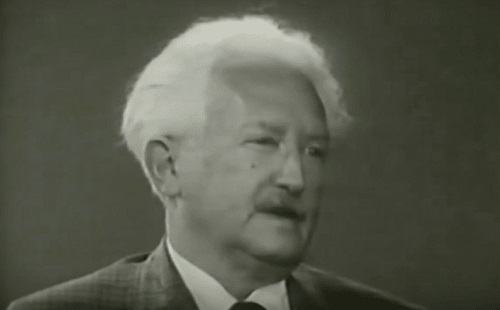Erikson's Stages of Psychosocial Development

Erikson’s stages of psychosocial development refer to a comprehensive psychoanalytical theory that identifies a series of stages a healthy individual must experience throughout their lifetime. Each stage is characterized by a psychosocial crisis of two conflicting forces.
Erik Erikson, like Sigmund Freud, believed that personality developed in a series of stages. The fundamental difference between them is that Freud based his theory on a series of psychosexual stages. Erikson, on the other hand, focused on psychosocial development. He was interested in how interaction and social relationships played a role in growth and development.
“A man’s conflicts represent what he ‘really’ is.”
-Erik Erikson-
Stages of psychosocial development
Each one of the eight stages that Erikson described in his theory draws on the preceding stages, providing a path for the following stages.

Erikson proposed that people experienced a conflict that served as a turning point in their development, like a stimulus for evolution, in each of the stages. These conflicts are meant to develop (or not develop) a certain psychological quality. During each stage, the potential for personal growth is high, but the potential for failure is also high.
Therefore, if a person successfully faces a conflict, they’ll pass that stage with a newfound psychological strength that will benefit them for the rest of their lives. But if they don’t effectively overcome those conflicts, they may not develop the skills they need to excel in the following stages.
Erikson also posited that a sense of competence motivated behaviors and actions. Thus, each stage of his theory refers to becoming competent in an area of life. If they manage the stage well, the person will gain a sense of mastery. But if they manage the stage poorly, the person will be left with a sense of inadequacy in that area of their development.
Stage 1: Trust vs. Mistrust (0-18 months)
In the first of the development stages, children learn to trust – or not trust – others. Trust has a lot to do with attachment, relationship management, and the extent to which the child expects others to meet their needs. Because a baby is completely dependent, the development of trust is based on the reliability and quality of the child’s caregivers, especially their mother.
If parents expose their child to an affectionate relationship that prioritizes trust, it’s likely that the child will also adopt this position before the world. If parents don’t provide a safe environment and don’t meet the child’s basic needs, they’ll probably learn not to expect anything from others. The development of distrust can lead to frustration, suspicion, or insensitivity.
Stage 2: Autonomy vs. Shame/Doubt (18 months – 3 years)
In the second stage, children acquire a certain degree of control over their bodies, which in turn increases their autonomy. By successfully completing tasks on their own, they gain a sense of independence. Thus, by allowing children to make decisions and gain control, parents and caregivers can help children develop a sense of autonomy.
Children who successfully complete this stage usually have healthy self-esteem, while those who don’t usually feel unstable. Erikson believed that striking a balance between autonomy, shame, and doubt would lead to volition, which is the belief that children can act intentionally, within reasonable limits.
Stage 3: Initiative vs. Guilt (3-5 years)
In Erikson’s third proposed stage, children begin to strengthen their power and control over the world through play, an invaluable framework for social interactions. When they achieve an ideal balance of individual initiative and the willingness to work with others, they develop a sense of purpose.
Children who are successful in this stage feel confident and trusted to guide others. Those who don’t achieve these qualities likely feel a sense of guilt, have doubts, and lack initiative.
Guilt is good in the sense that it shows children’s ability to recognize when they’ve done something wrong. Nevertheless, excessive or undeserved guilt can cause children to reject challenges because they don’t feel capable of facing them. Guilt can often feed fear.

Stage 4: Industry vs. Inferiority (5-13 years)
Children in this stage begin to perform more complicated tasks. Furthermore, their brains reach a high degree of maturity, which lets them begin to manage abstract topics. They can also recognize their abilities as well as their peers’ abilities. In fact, some children insist on being given more challenging and demanding tasks. When they complete those tasks, they hope to be recognized.
Finding balance in this stage leads children to develop a sense of confidence in their abilities to manage the tasks they’re given. It’s also important that they begin to gauge the challenges they can realistically face and the ones they can’t.
If children don’t perform as well as they desire, a sense of inferiority can develop. If this feeling isn’t addressed adequately and the child doesn’t receive help in managing their emotions, they may end up rejecting any task that’s difficult out of fear of experiencing that feeling again. Hence, it’s important to consider the child’s effort when evaluating a task, separating it from the result.
Stage 5: Identity vs. Role Confusion (13-21 years)
In the fifth stage, children become teenagers. They find their sexual identity and begin to design an image of the person that they want to be in the future. As they grow, they try to find their purpose and role in society, as well as solidify their unique identity.
In this stage, young people also discern which activities are appropriate for their age and which are considered “childish.” They must find a compromise between what they expect from themselves and what others expect of them. For Erikson, completing this stage successfully lays a foundation for adulthood.
Stage 6: Intimacy vs. Isolation (21-39 years)
In this stage, teenagers become young adults. The confusion between identity and role is coming to an end. Normally at this stage, it’s still a priority for young adults to please others and “fit in.” However, this is also the stage where they begin to draw their own red lines: things that they won’t sacrifice to please someone else.
It’s true that this also happens as a teenager, but the meaning is different. They begin to stop being reactive and take initiative and become active instead.
Once people establish their identities, they’re ready to make long-term commitments to other people. They become capable of forming intimate and reciprocal relationships, and willingly make the sacrifices and commitments that those relationships require. If a person can’t form those intimate relationships, they may begin to feel a sense of unwanted isolation.
If a person doesn’t find a partner during this stage, they might feel isolated or lonely. Isolation can create insecurities and a sense of inferiority out of fear of what other people may think. They may believe that they’re not good enough for other people, and that can lead to self-destructive tendencies.
Stage 7: Generativity vs. Stagnation (40-65 years)
During adulthood, people continue building their lives and focus on their careers and families. Generativity refers to caring for people outside of their close circle of family and friends. As people begin to enter “middle age,” their vision extends from their direct environment, including themselves and their family, to a wider and more complete image that includes their society and their legacy.
At this stage, people recognize that life isn’t just about them. Through their actions, they hope to make contributions that will become part of their legacy. When someone achieves this goal, they feel successful. On the other hand, if they don’t feel that they’ve contributed anything, they may think that they haven’t done, or aren’t prepared to do, anything significant.
Generativity isn’t necessary for adults. However, lacking it can rob a person of a great feeling of achievement.

Stage 8: Ego Integrity vs. Despair (65 years and above)
In the last stage of psychosocial development, people can choose integrity or despair. We might think of aging as an accumulation of losses that demand compensation. On the other hand, there’s a feeling that more time has been left behind than the time that lies ahead.
Looking at the past this way can either create despair and nostalgia or, in contrast, a feeling that everything we’ve shared and achieved has been worthwhile. One of those two views indicates what a person expects from the present and from the future.
People who have a complete vision of their lives don’t have problems coming to terms with their own past. They reaffirm their existence and recognize its importance, not just for themselves, but also for others.
Final thoughts
One of the strengths of the psychosocial theory is that it provides a wide framework that we can use to see development over the course of a lifetime. It also lets us emphasize the social nature of humans and the influence that social relationships have on our development.
However, one might question if Erikson’s psychosocial development stages should be considered sequential and if they only happen within the noted age ranges. There’s a debate over whether or not people only try to define their identity during their teenage years, or if one stage can’t begin until the other has completely ended.
One important weakness of Erikson’s stages of psychosocial development is that it doesn’t describe the exact actions needed to resolve conflicts. In this sense, the theory doesn’t detail exactly what type of experiences are necessary to move on to the next stage.
Erikson’s stages of psychosocial development refer to a comprehensive psychoanalytical theory that identifies a series of stages a healthy individual must experience throughout their lifetime. Each stage is characterized by a psychosocial crisis of two conflicting forces.
Erik Erikson, like Sigmund Freud, believed that personality developed in a series of stages. The fundamental difference between them is that Freud based his theory on a series of psychosexual stages. Erikson, on the other hand, focused on psychosocial development. He was interested in how interaction and social relationships played a role in growth and development.
“A man’s conflicts represent what he ‘really’ is.”
-Erik Erikson-
Stages of psychosocial development
Each one of the eight stages that Erikson described in his theory draws on the preceding stages, providing a path for the following stages.

Erikson proposed that people experienced a conflict that served as a turning point in their development, like a stimulus for evolution, in each of the stages. These conflicts are meant to develop (or not develop) a certain psychological quality. During each stage, the potential for personal growth is high, but the potential for failure is also high.
Therefore, if a person successfully faces a conflict, they’ll pass that stage with a newfound psychological strength that will benefit them for the rest of their lives. But if they don’t effectively overcome those conflicts, they may not develop the skills they need to excel in the following stages.
Erikson also posited that a sense of competence motivated behaviors and actions. Thus, each stage of his theory refers to becoming competent in an area of life. If they manage the stage well, the person will gain a sense of mastery. But if they manage the stage poorly, the person will be left with a sense of inadequacy in that area of their development.
Stage 1: Trust vs. Mistrust (0-18 months)
In the first of the development stages, children learn to trust – or not trust – others. Trust has a lot to do with attachment, relationship management, and the extent to which the child expects others to meet their needs. Because a baby is completely dependent, the development of trust is based on the reliability and quality of the child’s caregivers, especially their mother.
If parents expose their child to an affectionate relationship that prioritizes trust, it’s likely that the child will also adopt this position before the world. If parents don’t provide a safe environment and don’t meet the child’s basic needs, they’ll probably learn not to expect anything from others. The development of distrust can lead to frustration, suspicion, or insensitivity.
Stage 2: Autonomy vs. Shame/Doubt (18 months – 3 years)
In the second stage, children acquire a certain degree of control over their bodies, which in turn increases their autonomy. By successfully completing tasks on their own, they gain a sense of independence. Thus, by allowing children to make decisions and gain control, parents and caregivers can help children develop a sense of autonomy.
Children who successfully complete this stage usually have healthy self-esteem, while those who don’t usually feel unstable. Erikson believed that striking a balance between autonomy, shame, and doubt would lead to volition, which is the belief that children can act intentionally, within reasonable limits.
Stage 3: Initiative vs. Guilt (3-5 years)
In Erikson’s third proposed stage, children begin to strengthen their power and control over the world through play, an invaluable framework for social interactions. When they achieve an ideal balance of individual initiative and the willingness to work with others, they develop a sense of purpose.
Children who are successful in this stage feel confident and trusted to guide others. Those who don’t achieve these qualities likely feel a sense of guilt, have doubts, and lack initiative.
Guilt is good in the sense that it shows children’s ability to recognize when they’ve done something wrong. Nevertheless, excessive or undeserved guilt can cause children to reject challenges because they don’t feel capable of facing them. Guilt can often feed fear.

Stage 4: Industry vs. Inferiority (5-13 years)
Children in this stage begin to perform more complicated tasks. Furthermore, their brains reach a high degree of maturity, which lets them begin to manage abstract topics. They can also recognize their abilities as well as their peers’ abilities. In fact, some children insist on being given more challenging and demanding tasks. When they complete those tasks, they hope to be recognized.
Finding balance in this stage leads children to develop a sense of confidence in their abilities to manage the tasks they’re given. It’s also important that they begin to gauge the challenges they can realistically face and the ones they can’t.
If children don’t perform as well as they desire, a sense of inferiority can develop. If this feeling isn’t addressed adequately and the child doesn’t receive help in managing their emotions, they may end up rejecting any task that’s difficult out of fear of experiencing that feeling again. Hence, it’s important to consider the child’s effort when evaluating a task, separating it from the result.
Stage 5: Identity vs. Role Confusion (13-21 years)
In the fifth stage, children become teenagers. They find their sexual identity and begin to design an image of the person that they want to be in the future. As they grow, they try to find their purpose and role in society, as well as solidify their unique identity.
In this stage, young people also discern which activities are appropriate for their age and which are considered “childish.” They must find a compromise between what they expect from themselves and what others expect of them. For Erikson, completing this stage successfully lays a foundation for adulthood.
Stage 6: Intimacy vs. Isolation (21-39 years)
In this stage, teenagers become young adults. The confusion between identity and role is coming to an end. Normally at this stage, it’s still a priority for young adults to please others and “fit in.” However, this is also the stage where they begin to draw their own red lines: things that they won’t sacrifice to please someone else.
It’s true that this also happens as a teenager, but the meaning is different. They begin to stop being reactive and take initiative and become active instead.
Once people establish their identities, they’re ready to make long-term commitments to other people. They become capable of forming intimate and reciprocal relationships, and willingly make the sacrifices and commitments that those relationships require. If a person can’t form those intimate relationships, they may begin to feel a sense of unwanted isolation.
If a person doesn’t find a partner during this stage, they might feel isolated or lonely. Isolation can create insecurities and a sense of inferiority out of fear of what other people may think. They may believe that they’re not good enough for other people, and that can lead to self-destructive tendencies.
Stage 7: Generativity vs. Stagnation (40-65 years)
During adulthood, people continue building their lives and focus on their careers and families. Generativity refers to caring for people outside of their close circle of family and friends. As people begin to enter “middle age,” their vision extends from their direct environment, including themselves and their family, to a wider and more complete image that includes their society and their legacy.
At this stage, people recognize that life isn’t just about them. Through their actions, they hope to make contributions that will become part of their legacy. When someone achieves this goal, they feel successful. On the other hand, if they don’t feel that they’ve contributed anything, they may think that they haven’t done, or aren’t prepared to do, anything significant.
Generativity isn’t necessary for adults. However, lacking it can rob a person of a great feeling of achievement.

Stage 8: Ego Integrity vs. Despair (65 years and above)
In the last stage of psychosocial development, people can choose integrity or despair. We might think of aging as an accumulation of losses that demand compensation. On the other hand, there’s a feeling that more time has been left behind than the time that lies ahead.
Looking at the past this way can either create despair and nostalgia or, in contrast, a feeling that everything we’ve shared and achieved has been worthwhile. One of those two views indicates what a person expects from the present and from the future.
People who have a complete vision of their lives don’t have problems coming to terms with their own past. They reaffirm their existence and recognize its importance, not just for themselves, but also for others.
Final thoughts
One of the strengths of the psychosocial theory is that it provides a wide framework that we can use to see development over the course of a lifetime. It also lets us emphasize the social nature of humans and the influence that social relationships have on our development.
However, one might question if Erikson’s psychosocial development stages should be considered sequential and if they only happen within the noted age ranges. There’s a debate over whether or not people only try to define their identity during their teenage years, or if one stage can’t begin until the other has completely ended.
One important weakness of Erikson’s stages of psychosocial development is that it doesn’t describe the exact actions needed to resolve conflicts. In this sense, the theory doesn’t detail exactly what type of experiences are necessary to move on to the next stage.
All cited sources were thoroughly reviewed by our team to ensure their quality, reliability, currency, and validity. The bibliography of this article was considered reliable and of academic or scientific accuracy.
- Erikson, Erik (2000). El ciclo vital completado. Barcelona: Ediciones Paidós Ibérica.
- Erikson, Erik (1983). Infancia y sociedad. Buenos Aires: Horme-Paidós.
- Erikson, Erik (1972). Sociedad y Adolescencia. Buenos Aires: Editorial Paidós.
- Erikson, Erik (1968, 1974). Identidad, Juventud y Crisis. Buenos Aires: Editorial Paidós.
This text is provided for informational purposes only and does not replace consultation with a professional. If in doubt, consult your specialist.







